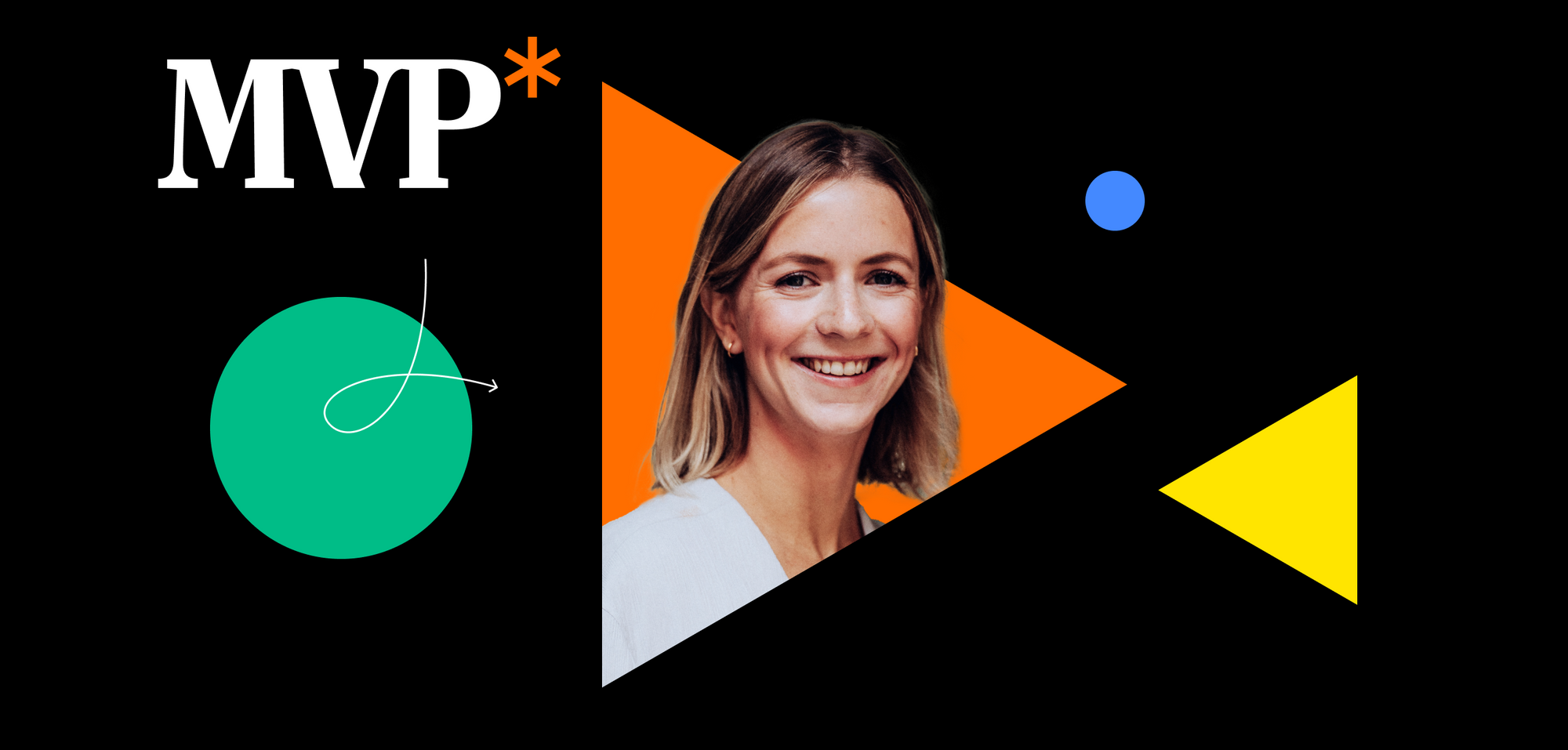The opposite of uncertainty is not certainty but openness to the unknown. Future Thinking is not fortune telling but sketching possible scenarios based on current data. This helps to create a set of strategies to be prepared for situations that could occur.
In the 22nd episode of MVP, Michal Blažej discusses with the Design & innovation specialist at the Government Office of the Slovak Republic, Lucia Ciranová, why organizations need to think about the future, how to identify and correctly apply trends, and why looking into the future is the key for today's decisions and achieving sustainability.
Minimum Viable Podcast is brought to you by the CX design studio Lighting Beetle*. It's usually recorded in the Slovak language, however, you can read an English transcription of this episode below. For more English content, including case studies and handouts, visit our Journal.
Why is it important to predict the future? How can we estimate what will happen in a few years? Can design be strategic? Today, I will be talking to Lucia Ciranova about topics like future thinking, strategic foresight, or anticipation studies in design. Lucia has worked with global brands such as Fjord London (now Accenture Song), Google, Adidas, Space 10 (IKEA Innovation Lab), as well as Tech for Good startups and public institutions in the UK and Scandinavia. Currently, she leads the design unit at the Research and Innovation Authority at the Government Office of the Slovak Republic. Lucia, welcome to MVP.
Thank you, Miško.
Today we want to talk about the future. You have dedicated a part of your career to this topic. Can you briefly tell us what strategic foresight or future thinking is?
If I were to express it humanely, I would say it's a strategic work with the future, where we use the future as a source of information and inspiration for our current thinking and decision-making.
Where did you do this?
I would say I'm still doing it in a way. It's a bit like design thinking. Once you learn it, you keep using it. After finishing my business design studies in Scandinavia, I started working at an agency in Copenhagen that focused on strategic foresight and future thinking. We created a series of methods on how to do it. It was ten years ago, so we were also pioneering this topic a bit in the European context.
Then I moved to London, where I worked at Fjord (now Accenture Song). They have a publication called Fjord Trends, which tracks the intersection of trends in human behaviour, design, and technology, from which they annually release a report. I was part of this team for five years, and it was beautiful work.
In 2020, I returned to Slovakia and wrote these reports from a one-room apartment in Petržalka, which was quite bizarre. Then I started working on the strategic plan for Bratislava 2030 and Slovakia 2030. We wrote strategic documents about where we wanted Slovakia to go in the next ten years. However, we didn't start from the current situation but from how we wanted the country to look in the future.
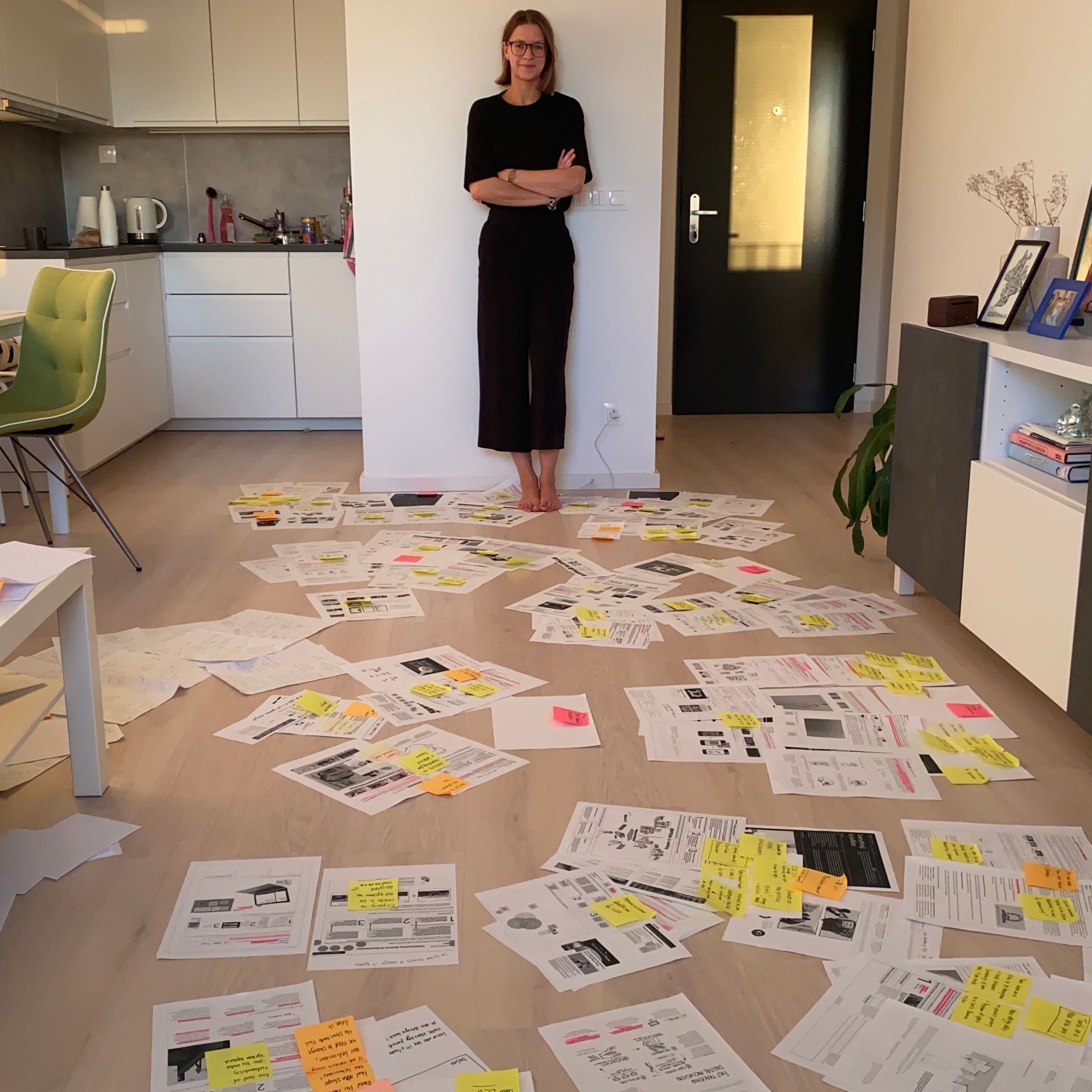
Why should organizations focus on this topic?
There are two reasons. The first is that organizations need certainty. A feeling that they know what awaits them. Often their work involves strategic planning. We believe that the opposite of the uncertainty we live in is certainty, but it's not true. On the contrary, it's a sense of openness to possibilities. Thinking about the future is not about fortune-telling from a crystal ball. It's about deriving insights and inspiration from concrete data. Based on that, we can create scenarios, according to which the company, brand, organization, city, or state can create a series of strategies. This allows them to frame an offer with which they go to the market.
The second thing is that we, as designers, make decisions in the present, but their impact will be seen only in the future. Future thinking allows us to imagine what kind of future we want to live in and based on this vision adjust our current decisions. It's informative in a way, but also inspirational because it's a way to work with uncertainty.
When we provide a vision that is inspiring and positive, it can motivate people and help them grasp the uncertainty ahead of them. It's important also from the perspective of the impact of our current designs. If we design them in today's mindset of human centricity, regardless of the planet, other people, or long-term sustainable growth, we cannot continue. It's essential to bring alternatives and new paradigms of the future that can influence how we think now.
The first part was quite an aha moment. Analytical thinking means there are many possibilities, and the goal is to get to one point. But future thinking is divergent thinking and means thinking about what everything could happen in the future. These are just examples of what might happen; it's not a definitive answer.
Yes, because we all think in patterns. We build on what we know. And what we know, we perceive empirically. There is a lot of data and information in the world, but if we can't use them in context or transform them into insights and human-understandable stories, it's useless. We're not trying to say it will be this way, so now let's make this specific move. We're trying to see the possibilities of everything possible.
"Future thinking allows us to envision the future we want to live in, and based on that adjust our current decisions."
I worked in the automotive and we were addressing the future of mobility. We weren't thinking about how many cars we have to produce by 2030. We talked about what our core business is. We don't sell cars, but we help people to move from point A to point B. We realized that we could do something quite unrelated to cars. Of course, it wasn't about stopping making cars now. We played with the idea of shared mobility and realized that our core business doesn't have to be just selling cars. This gives someone immersed in a specific industry an opportunity for a creative overview of what could be.
You also worked on the Bratislava 2030 document. How do you work with such a document?
There are two types of documents. One is trends, with which you can work more creatively. Bratislava 2030, however, is a strictly strategic document, and it's different. Future thinking was used there, from which a series of measures were derived, already designed for the anticipated future. It was much more analytical. We started with data that show how many people will live here, what the ageing and birth rate curve is, and so on. From this, we could create and plan, for example, the number of rental apartments, or where the tram will go.
Interestingly, the document was originally divided into ten areas, such as culture, transportation, and so on. We, at the Metropolitan Institute, merged it into one narrative from the citizen's perspective. Then we intertwined it with the goal of sustainable development, which is a city program obligation. There are long-term and short-term goals and an action plan that individual departments follow.
So, did that document show the future and set priorities?
Yes, it establishes the city's strategic priorities. It is also important for financing. When the city seeks funding from external sources, it can show that this is the project according to which goals will be achieved. It demonstrates that the city has some strategic direction.
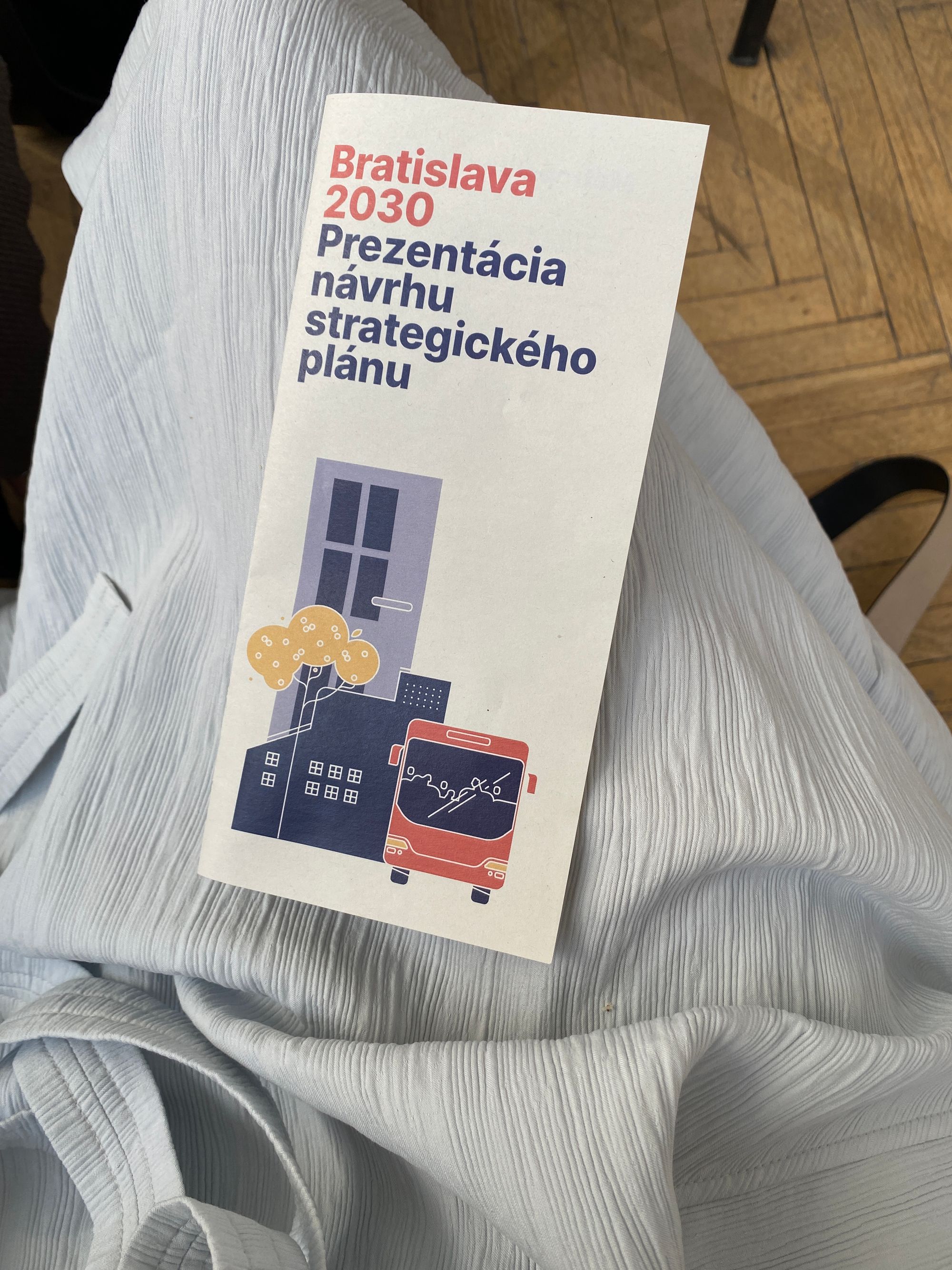
You mentioned that the second type is trends. It reminds me of Fjord Trends. What did that involve, and what is its application? Because there you didn't get to a specific solution. You rather described possibilities.
Yes. Often when consulting organizations create such trends, it has two ways of use. The first is that it opens the door to interesting conversations. I was part of a team where people from top management worldwide were involved. Many people who think a lot about it create a document together, which you can bring to Fortune 500 companies, and you start talking to them about what might happen in the future. Primarily, it's a marketing tool.
However, we also used it internally. For any project we had from a client, whether it was a new digital application or a new service design, we took that trend and applied it to the given industry. For example, we collaborated with a brand in the health and beauty sector. We presented trends in human behaviour and reflected on what it means for this particular client and how we can apply it. Based on these trends, we could anticipate the future of self-care, and we designed solutions.
Those trends must be at a much higher level than the plan for Bratislava, right?
The advantage is that trends cover the next year or two. That means it's understandable, and we always look at it from the perspective of human behaviour. People don't think in terms of industrial sectors but in terms of life situations or their needs, and human needs don't change. The only thing that changes is how we satisfy them.
"You can create a trend, but if the application fails, or you don't hit the right human need, people won't find it worth the change."
Trends may sound "meta" but at the same time, they're not because every year new technologies appear that slightly modify human behaviour. But you can always bring it down to a specific client. We don't live in a bubble, and everything is somehow interconnected. The skill lies in finding connections between different types of behaviour, between different trends, and the client's needs. Then you can design a product or service that has value for everyone.
If I need to design, for example, a new banking application, why should I even look at trends?
If we get a task to design a new digital bank, the first thing I would do is look at how people perceive value and wealth, what money means to them, what feelings they have about retirement, managing their finances, and so on. We would look at it from a higher perspective.
It's not just the assignment given to us by the bank but also what it means for a person in the context of their life. This is a meta-level, and we could do it based on some meta-research. We would conduct quick user research on how people feel about the future, financial security for themselves, and so on. Then I would look at technologies and the curves they follow. I would put it all together and see how we can create a future scenario. I would certainly not start with that we already have three such applications, so let's make a fourth one in a different colour.
The purpose of all this is to bring something new to the market?
To bring something new but also to realize the long-term impact of decisions. When we get such a task, the product will go to the market in a year or two. We must maintain competitiveness. We don't need to be current in two years; we need to be innovative in two years. And for that, you have to think 15 years ahead.
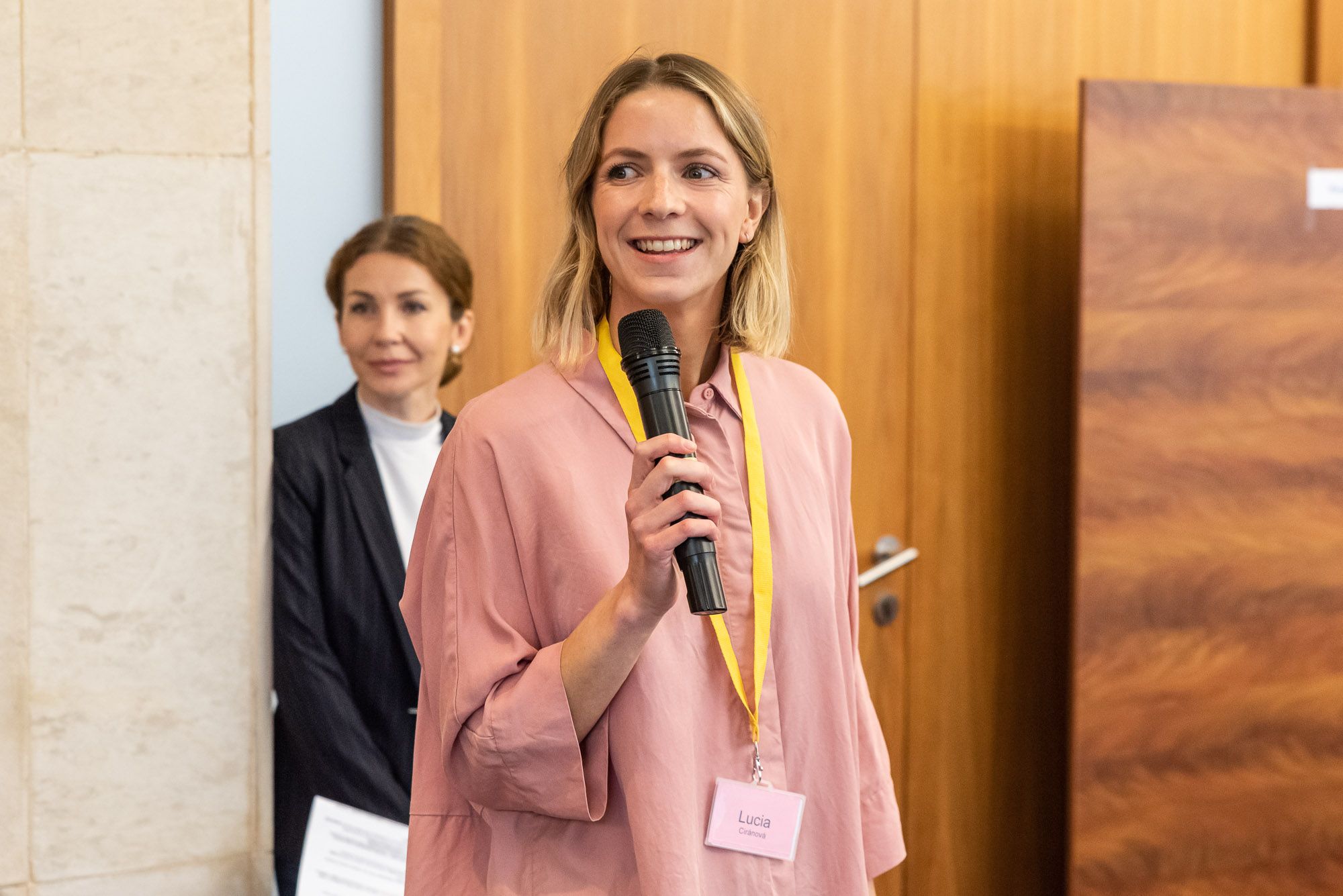
We were together at the Bratislava By Design conference, where the Creative Director and founder of the Selly agency presented a vision of a sustainable future for Stockholm. She showed a visualization with music and told stories about how Stockholm could look in the future, despite the upcoming climate crisis and so on. It was like a fairy tale about the future. What is it good for?
She did exactly what I was talking about at the beginning. She showed us the future, allowed us to touch it, and gave it to us as a source of information and inspiration for the present. She put the problem in a positive light. She showed us a positive solution. The city she showed us was beautiful, overgrown with flowers, and so on. It was a very nice narrative that said we live a bit differently, but we still deal with the same things - who we fall in love with, we deal with relationships with neighbours - very human things. Important is that people are not that interested in technologies as such. What you need to do is translate it into a human context and a specific human need.
What we saw was a speculative design. While future thinking is about strategic planning for the future or a series of tools that allow us to create some data-driven versions of the future, speculative design allows us to somehow materialize all this. Visualizing the future can go through stories or artefacts from the future that allow us, ordinary people, to use it as creative material, based on which we can design solutions.
So, it's actually about materializing the future.
She is a master of leadership. When she showed you this, suddenly you have a greater desire to work on it. You can imagine it. Such problems are not straightforwardly solvable. It requires a lot of collaboration. This is a very good tool that can bring together many stakeholders from different areas, who may have different partial goals and different intentions but they can bring them together for one shared vision.
We do the same thing at the Government Office. We focus on something called missions. The mission could be a healthy society or decarbonization of cities. It's one topic that concerns various things and can bring people together.
Often, when I read European materials, I understand that initiatives need to be somehow structured and connected so that we all go in the same direction in the Union.
A very nice example from history is NASA. They decided to land on the Moon, and that became their mission. People from different areas and expertise came to work together to achieve this goal.
I'm interested in how all of this relates. Organizations have their innovative approaches and say that they need to innovate. Is there a process for creating innovative strategies?
Innovation is a new way of looking at an old problem. Organizations are constantly struggling with old problems, many of which they can't solve. When I say a problem, it could be a money-making model or an operational model, simply the status quo. It is necessary to look at the problem in a new way.
"Ingenuity lies in how you can find connections between different types of behaviour, trends, and client needs."
The fact that we now lock these people in a room and tell them that we're going to do a design thinking workshop and stick post-its on the wall with a facilitator who took one course won't lead them anywhere. We have to look at the problem from a completely different perspective.
I'm interested in the practical aspect, how do trends actually emerge? How do you identify them?
Creating trends has three main steps. The first is the identification of signals, the second is the synthesis of signals into trends, and the third is the application of trends to create added value.
Can you please explain the individual steps?
I'll talk about the trend process as we did it at Fjord. First, it's necessary to identify signals. Signals can be, for example, a form of behaviour, a new product, and so on. Small things that are distributed worldwide, but when you aggregate them, you see a trend. When I was at Fjord, they had around 2000 designers worldwide. Each of them proposed what they thought was a trend around them. We combined these studies from around the world and examined whether there was a common denominator that could confirm a global trend.
There were a total of 50 outputs. I looked at it for two days and came up with answers. This is such an analytical-synthetic job. You have to find connections between individual things and find meaning in them (sense-making). Then we met in a smaller group where we presented the results and directions we could go. Whether these hypotheses could be trends. We had about 10 hypotheses, from which we then again conducted a survey and looked for evidence from around the world that would confirm it.
A trend always has two parts: "what is happening" and "what is next." "What is happening" is synthetic work where we say what we are basing it on. At “what is next", we always look at what is relevant for designers and for the kind of work we do. Here, the marketing aspect comes in, and the question arises of how to create value for the target audience. So we looked at how we could apply this hypothesis or trend for designers and somewhat predict what it could mean. From this, we got about 5 trends, and then the task was to take each trend and create an industrial planning document for it. Each trend was again processed for a specific segment.
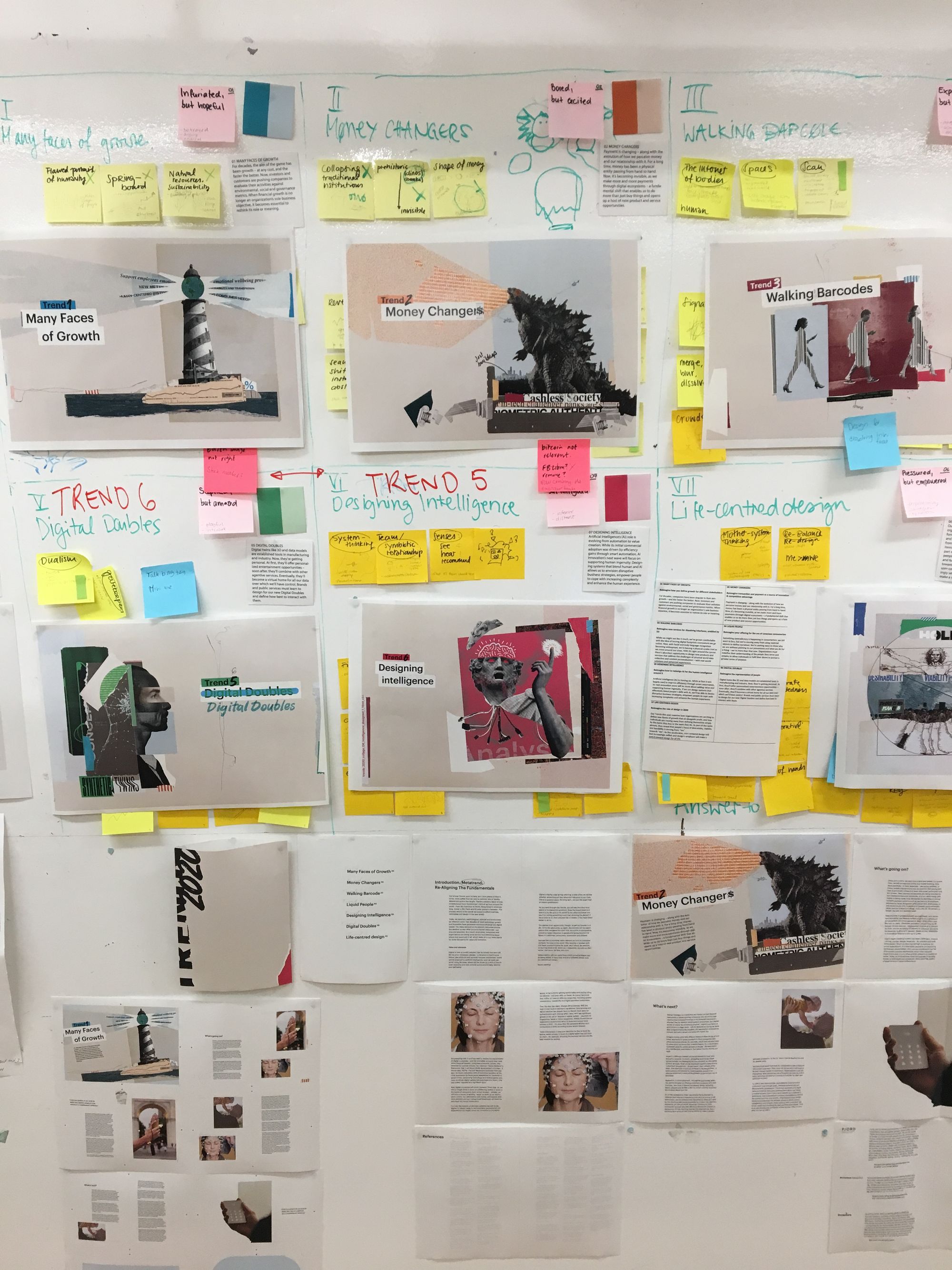
Can this be done on a small scale?
When I was in Copenhagen, there were three of us, so yes.
So, in this case, inspirations were specific designers and their experience?
Yes. In addition, you can also do some quantitative research where you gather information or build on what has already been collected. When we had more time, we researched hypotheses to statistically confirm them. There are various approaches.
You talked about designers. What role do ordinary people or ordinary users play here? Do they enter this process at all?
All of us who create these are ordinary people. In this case, those designers are also ordinary people. They are also our users. So, we didn't validate it. The process itself was validation. If we were to design a specific solution or service based on it, we might validate it secondarily, but you can't validate the future with people. The fact that something is a trend comes from specific human behaviour, which is validation in itself.
In the previous podcast, I interviewed the Head of Research from AirBank, Petr Šmíd, and he said an interesting thing that trends do travel. He observes them, and when a trend is close to the Czech Republic, he starts applying it. Is there something like a global trend versus a local trend? Or can local companies also be guided by global trends?
It's about the skillfulness of taking a global trend and applying it to the local market. This, in my opinion, is the task and use of future thinking. People's or country's needs don't change; only the ways we satisfy them do. This means that we can take global trends and think about how we can apply them so that it makes sense in the context of the Slovak market. When Alexa was released, in London, people were talking about how groundbreaking and life-changing it was, but I didn't think so because of language diversity. English is quite straightforward compared to Slovak or Czech. The question arose whether Alexa could understand us.
In the English context, it's a great trend. In another context, it's necessary to evaluate whether it's applicable or not. I would like us not to be just the country that looks at what's happening in the West and then copies it in five years but to look at what could be in the global context and have the courage to be among the first to apply it.
I would like to talk more about working with trends in ordinary design work? Where is there room for the future in design thinking?
When we look at the general design narrative in the world, I think these two concepts work quite hand in hand. However, a common mistake is that in the first Discover phase, we only look at what is now, and consequently, we don't move anywhere. At the same time, a big criticism of design thinking is that it primarily looks at the human experience as a consumer. It makes sense because the consumer brings us profit, but it's a view of an individual.
“When we get stuck in the perspective of only our consumer as an individual, we forget about the impact of our design on the planet, the environment, or people who are not our consumers.”
When we get stuck in this cycle, we forget about the impacts of our design on the planet, the environment, or other people who are not our consumers. We need to realize that everything in this world was designed by someone, and we as designers have a fundamental impact on what this world looks like and will look like in the future. During Covid, for example, we saw how the digital gap increased. While some had the latest iPhones, and our children were learning on iPads, others didn't even have access to the internet or a computer. It is necessary to reflect on responsibility in design.
A very important topic, and I'm curious how agencies will deal with it. We now live in a world where design agencies advocate for sustainability, but clients don't buy it as much yet. At the same time, there is tremendous pressure for this issue not to disappear from the table so that it's not only about profit but also about sustainability.
In my opinion, the conversation must be about profit that is also sustainable in every aspect. I don't think the topic has disappeared from the table. I understand that I'm saying this in the context of a recession and inflation, and these nice and beautiful topics like sustainability are less important than the survival of the company, but I think sustainability is already a question of survival.
We need to let go of the idea that sustainability is a new luxury and it only means buying more expensive things because it's better. We need to think about how to change systems and standards so that sustainability becomes the new norm. However, we're already talking about the fact that it must come from the top. Some high-level legislative measures that we choose.
It's a question of the coming years. All agencies have the topic of a sustainable world on their main pages, but at the same time, I see layoffs. It's enormous pressure.
Yes, but at the same time, it's great that this topic is on the table. I remember when we made a trend about recession five years ago. Our core business at Accenture Song was selling profit at that time, but we pushed it through and went public with it. And this is important. You take a paradigm that you didn't even know that could be challenged, you challenge it and ask, "What if?"
Is future thinking a process or a mindset?
It's both, like with design thinking. First of all, you have to grasp it as a mindset, that you think in the long term. Just as in design thinking, you work in uncertainty and you have to be comfortable with it. And then there is a series of processes or ways to do it.
We need to realize and remind ourselves that even CEOs of large organizations are people at the end of the day. They also think about what country they want to live in, the quality of their life, the quality of their children's food, and so on. Here, future thinking can beautifully include the human factor. Sometimes it's nice to step away from technology and remind yourself that what really matters are human relationships, connection with nature, and so on.
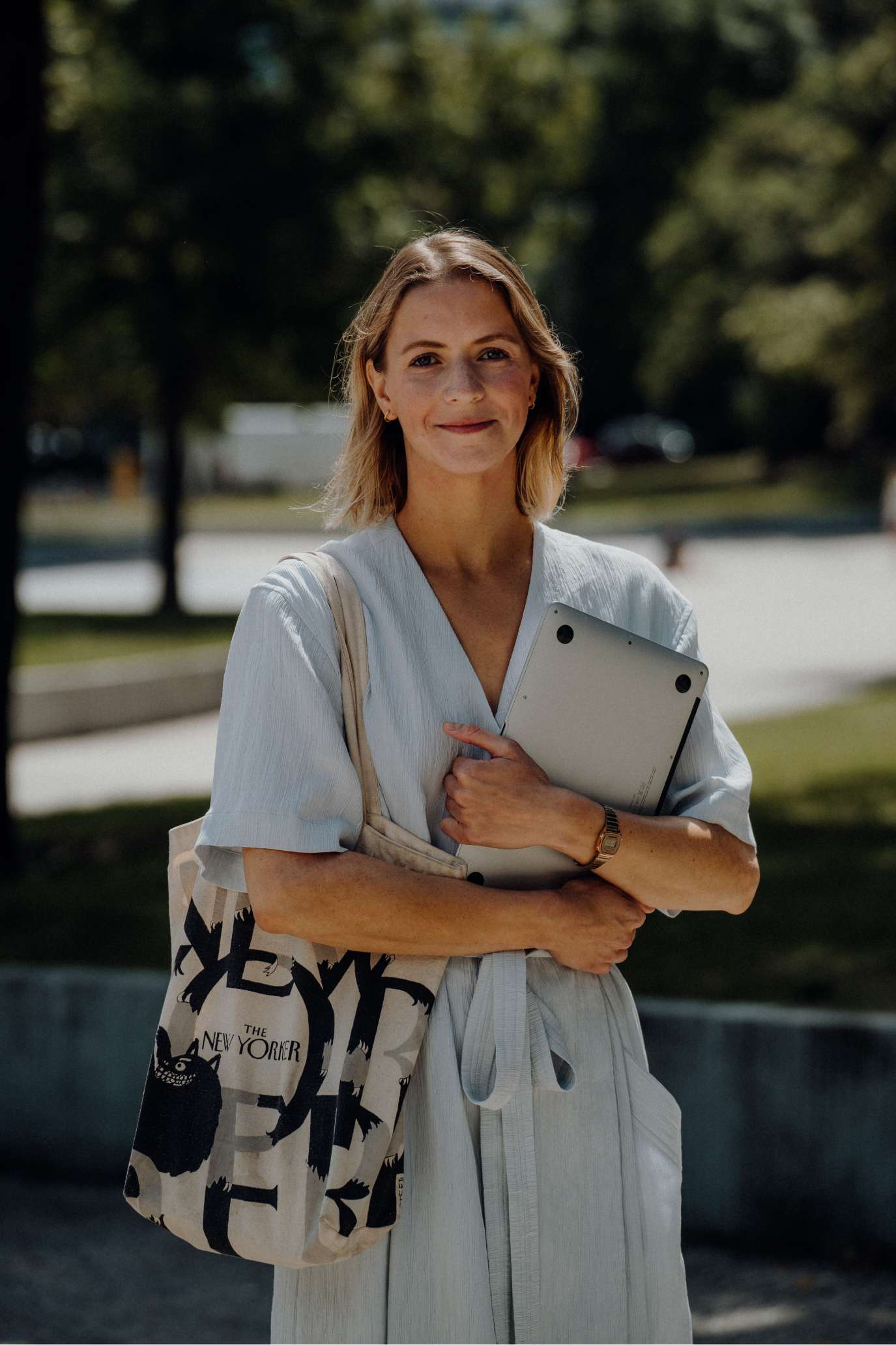
What if you don't hit the trends?
It's not that the trends themselves would not fulfil. It's that their application to the broader world was faulty. For example, there were many trends around VR (virtual reality), AR (augmented reality), or the Metaverse. Everyone thought about how it would change the world. When we wrote about this trend, we were very hesitant. We saw it everywhere, but we weren't sure about it. We didn't think Metaverse was solving a real human problem.
So the trend about technology was true, but the problem arose when companies applying it either didn't hit the right use case/human need or their user experience wasn't good enough for people to switch to pick it up. That's why I'm very sceptical about VR. The hardware itself is uncomfortable and heavy; you don't want that on your eyes. The screen of your phone is enough. For ordinary people, the experience is not worth that radical change.
However, there are industries where it makes sense, such as pilot training or gaming. But it doesn't make sense to do everything in VR. For example universities. The added value of education is precisely in the physical contact, building a network, etc., which you can't do in VR. You can make a trend, but when the application fails or you don't hit the right human need, people don't find it worth that radical change.
We talked about how speculative design is the embodiment of trends. Can you give some more examples?
You can see speculative design in galleries or museums, where they try to show you a future scenario and materialize it. It's often presented narratively. You can create artefacts from the future, such as a futuristic milk package. One of my favourite applications is design fiction. It's similar to science fiction, but with the difference that it focuses on the design aspect.
"The conversation must be about the profit that is also sustainable in every aspect. I think sustainability is already a question of survival."
My favourite example is the movie Minority Report, starring Tom Cruise. There's a scene where he's in a control room of a spaceship, where there are numerous touch screens. One of the movie's investors came up with the touch screen, which we hadn't known until then, and it wouldn't have occurred to us that we could use it like that someday. When you present new future technology to people, you have to show it in some contemporary context that is understandable to them.
Just the narrative or anything materialized gives a human face to that technology.
For example, the series Black Mirror is a very nice example of speculative design.
The last question I ask every guest. What is the biggest design challenge you would like to solve in your life?
How to ensure that all people in the world have a certain acceptable quality of life without depleting the resources of our planet. The more short-term and local challenge that I'm working on at the Government Office is how to make design a tool and a way of thinking and incorporate it into our culture so that solutions are designed for citizens and not for clerks.
Well, I could sign what you just said, and I'd be more than happy to help you with that.
I would like not to cry every time I have to use slovensko.sk.
Listen to the whole interview with Lucia Ciranová in Slovak:
Minimum Viable Podcast is brought to you every two months by the design studio Lighting Beetle*, which focuses on creating an exceptional customer experience.
Design is all around us. Minimum Viable Podcast explores design with a small “d” – the one that looks for solutions to people's problems. In it, together with our guests, we address topics that are related to design, but we normally do not associate with it. Thanks to the Zeldeo production studio and our production manager Mojmír Procházka for the cooperation.
We are looking forward to every listen, follow, share, and suggestion for improvement. You can send us your tips for interesting personalities with whom we can talk about design to podcast@lbstudio.sk.
Enjoy!

